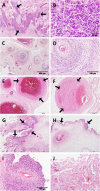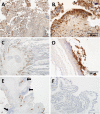Pathogenic outcome following experimental infection of sheep with Chlamydia abortus variant strains LLG and POS
- PMID: 28494018
- PMCID: PMC5426687
- DOI: 10.1371/journal.pone.0177653
Pathogenic outcome following experimental infection of sheep with Chlamydia abortus variant strains LLG and POS
Abstract
This study investigated the pathogenesis of two variant strains (LLG and POS) of Chlamydia abortus, in comparison to a typical wild-type strain (S26/3) which is known to be responsible for late term abortion in small ruminants. Challenge with the three strains at mid-gestation resulted in similar pregnancy outcomes, with abortion occurring in approximately 50-60% of ewes with the mean gestational lengths also being similar. However, differences were observed in the severity of placental pathology, with infection appearing milder for strain LLG, which was reflected in the lower number of organisms shed in vaginal swabs post-partum and less gross pathology and organisms present in placental smears. Results for strain POS were somewhat different than LLG with a more focal restriction of infection observed. Post-abortion antibody responses revealed prominent differences in seropositivity to the major outer membrane protein (MOMP) present in elementary body (EB) preparations under denaturing conditions, most notably with anti-LLG and anti-POS convalescent sera where there was no or reduced detection of MOMP present in EBs derived from the three strains. These results and additional analysis of whole EB and chlamydial outer membrane complex preparations suggest that there are conformational differences in MOMP for the three strains. Overall, the results suggest that gross placental pathology and clinical outcome is not indicative of bacterial colonization and the severity of infection. The results also highlight potential conformational differences in MOMP epitopes that perhaps impact on disease diagnosis and the development of new vaccines.
Conflict of interest statement
Figures




Similar articles
-
Identification of the 1B vaccine strain of Chlamydia abortus in aborted placentas during the investigation of toxaemic and systemic disease in sheep.N Z Vet J. 2015 Sep;63(5):284-7. doi: 10.1080/00480169.2015.1018365. Epub 2015 Jun 18. N Z Vet J. 2015. PMID: 25695509
-
Recent advances on ovine chlamydial abortion.Vet Res. 1998 May-Aug;29(3-4):275-88. Vet Res. 1998. PMID: 9689742 Review.
-
Genomic evidence that the live Chlamydia abortus vaccine strain 1B is not attenuated and has the potential to cause disease.Vaccine. 2018 Jun 14;36(25):3593-3598. doi: 10.1016/j.vaccine.2018.05.042. Vaccine. 2018. PMID: 29759381 Free PMC article.
-
Seroprevalence and molecular characterization of Chlamydia abortus in frozen fetal and placental tissues of aborting ewes in northeastern Algeria.Trop Anim Health Prod. 2016 Feb;48(2):255-62. doi: 10.1007/s11250-015-0944-y. Epub 2015 Nov 2. Trop Anim Health Prod. 2016. PMID: 26526957
-
New challenges for vaccination to prevent chlamydial abortion in sheep.Comp Immunol Microbiol Infect Dis. 2012 May;35(3):271-6. doi: 10.1016/j.cimid.2011.12.001. Epub 2011 Dec 30. Comp Immunol Microbiol Infect Dis. 2012. PMID: 22209689 Review.
Cited by
-
The 1B vaccine strain of Chlamydia abortus produces placental pathology indistinguishable from a wild type infection.PLoS One. 2020 Nov 16;15(11):e0242526. doi: 10.1371/journal.pone.0242526. eCollection 2020. PLoS One. 2020. PMID: 33196660 Free PMC article.
-
Distribution and Severity of Placental Lesions Caused by the Chlamydia abortus 1B Vaccine Strain in Vaccinated Ewes.Pathogens. 2021 Apr 30;10(5):543. doi: 10.3390/pathogens10050543. Pathogens. 2021. PMID: 33946380 Free PMC article.
-
Efficacy of Two Chlamydia abortus Subcellular Vaccines in a Pregnant Ewe Challenge Model for Ovine Enzootic Abortion.Vaccines (Basel). 2021 Aug 13;9(8):898. doi: 10.3390/vaccines9080898. Vaccines (Basel). 2021. PMID: 34452023 Free PMC article.
-
Evaluation of the Protective Efficacy of Different Doses of a Chlamydia abortus Subcellular Vaccine in a Pregnant Sheep Challenge Model for Ovine Enzootic Abortion.Animals (Basel). 2024 Oct 17;14(20):3004. doi: 10.3390/ani14203004. Animals (Basel). 2024. PMID: 39457934 Free PMC article.
-
Whole genome de novo sequencing and comparative genomic analyses suggests that Chlamydia psittaci strain 84/2334 should be reclassified as Chlamydia abortus species.BMC Genomics. 2021 Mar 6;22(1):159. doi: 10.1186/s12864-021-07477-6. BMC Genomics. 2021. PMID: 33676404 Free PMC article.
References
-
- Stamp JT, McEwen AD, Watt JAA, Nisbet DI. Enzootic abortion in ewes. I. Transmission of the disease. Vet Rec. 1950;62: 251–254. - PubMed
-
- Buxton D. Potential danger to pregnant women of Chlamydia psittaci from sheep. Vet Rec. 1986;118: 510–511. - PubMed
-
- Pospischil A, Thoma R, Hilbe M, Gresi P, Gebbers JO. Abortion in woman caused by caprine Chlamydophila abortus (Chlamydia psittaci serovar 1). Swiss Med Wkly. 2002;132: 64–66. doi: 2002/05/smw-09911 - PubMed
-
- Essig A, Longbottom D. Chlamydia abortus: New aspects of infectious abortion in sheep and potential risk for pregnant women. Curr Clin Microbiol Rep. 2015;2: 22–34.
-
- Longbottom D, Coulter LJ. Animal chlamydioses and zoonotic implications. J Comp Pathol. 2003;128: 217–244. - PubMed
MeSH terms
Substances
LinkOut - more resources
Full Text Sources
Other Literature Sources
Medical
Molecular Biology Databases

